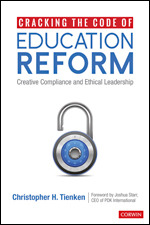Cracking the Code of Education Reform
Creative Compliance and Ethical Leadership
- Christopher H. Tienken - Seton Hall University, Associate Professor
Foreword by Joshua Starr, CEO of PDK International
Leadership | Program Development & Evaluation | School Change, Reform, & Restructuring
Although educational reform is intended for positive change, sometimes it misses the mark. However, when school leaders capitalize on the positive aspects of reforms they can strategize to ensure the best outcomes for students.
Christopher Tienken, professor and international speaker, shares his insights on how to identify both positive and negative aspects of education reform to maximize the benefits for students. This book introduces a practical framework for interpreting educational reform within an evidence-based practice, and provides thoughtful ways to finesse results out of challenging policies. Designed for use on the ground level, this book features:
• Seven specific creative compliance strategies to maximize student and educator success
• Case studies that illustrate how to critique reforms and take action
• Reflective questions to guide evaluation and application
• Ethical decision-making checklist
Analyzing both successful and unsuccessful reform ideas from the past, this book champions creative compliance and how to lead innovatively/judiciously.
In Cracking the Code of Education Reform Creative Compliance and Ethical Leadership Chris Tienken offers the reader an action plan for how to stay true to core values and ethics and still implement education reform on behalf of all students. Even in the era of “accountability” Tienken reminds us all that the student, not any test or reform is our “why” as educational leaders. Throughout the book, the “Try This” features offer in the moment professional learning opportunities. This is a must read for anyone interested in education!
This text tackles the challenges of critiquing education reform, encouraging readers to consider how best to engage with this. Broken into manageable sections and written in a thoughtful manner with reference to research and theory, it offers a helpful insight to its topic. It is well-suited to a postgraduate or professional readership.
